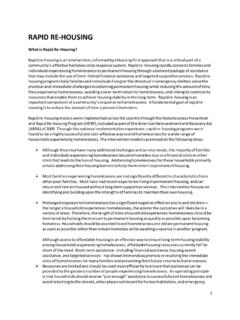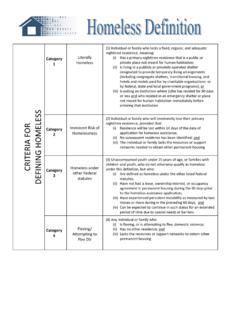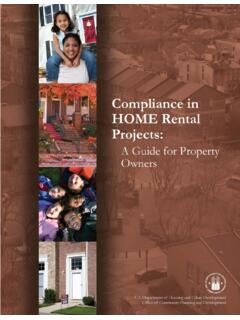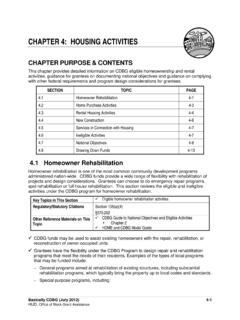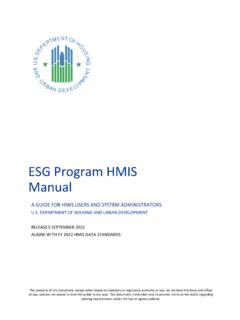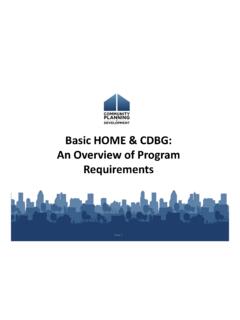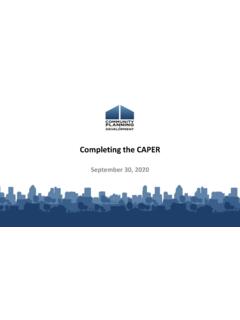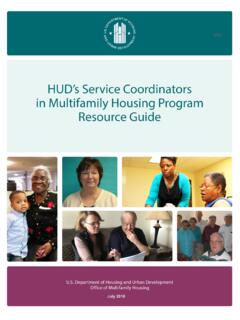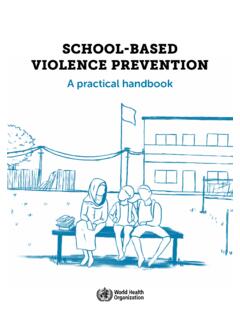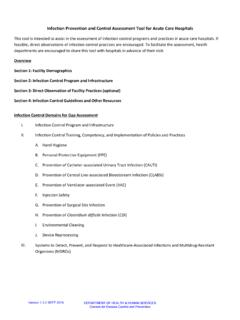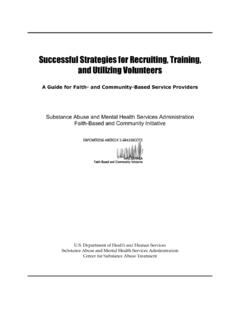Transcription of Case Management - Homeless Prevention and Rapid Re …
1 Page 1 INTRODUCTION AND BACKGROUND Case Management is essential to the success of the Homeless Prevention and Rapid Re-housing Program (HPRP). Effective case managers provide a blend of assessment and coordination services. They possess in-depth knowledge of communities and available services and housing, mixed with genuine empathy and respect for the families and individuals seeking their assistance. HPRP case managers use this expertise and empathy to provide services that are just enough to help families move through crisis towards stability.
2 A meeting with a case manager is required in order to receive HPRP assistance, although it is not necessarily the first step. Some communities might have a screening, intake, assessment and eligibility determination process that precedes assignment to a case manager, while other communities will have case managers performing the eligibility task. Regardless of the arrangement, the meeting with the case manager should be regarded not only as a program requirement, but also as an early opportunity to help a household improve its housing stability during and beyond the period of HPRP assistance.
3 Case Management has been defined as a collaborative process that assesses, plans, implements, coordinates, monitors, and evaluates the options and services required to meet the client s health and human service needs. It is characterized by advocacy, communication, and resource Management and promotes quality and cost-effective interventions and Within HPRP, case Management focuses on housing stability and placement, with an emphasis on the arrangement, coordination, monitoring, and delivery of services related to housing needs and improving housing stability.
4 Due to the time-limited nature of HPRP services (short or middle term assistance), case Management in this context focuses on needs that can be addressed within a set time frame and with available Management Homelessness Prevention and Rapid Re-housing1 Commission for Case Manager Certification (CCMC). Definition and Philosophy of Case Management . About this Document This document explores the role of case Management in preventing homelessness and in rapidly return-ing Homeless individuals and families to housing stability.
5 Tasks such as assessment and planning are described, providing the case manager specific information about case Management within the HPRP program. The document can also be useful for system planners who are considering job descriptions, performance measures, and contract provisions within the HPRP program. A Case Scenario is included in this document to demonstrate how a potential client s or household s needs may or may not be ad-dressed through the Homeless Prevention and Rapid Re-housing Program and how a case manager can work with individuals or families to plan the right mix of services.
6 Case Scenario boxes are presented throughout this document to illustrate how case Management principles can be applied to a household. Case Management Tips are easily identified by the icon. An example of a Housing Stabilization Plan is included as Appendix A and is populated with information applicable to the case scenario. Page 2 HOMELESSNESS Prevention AND Rapid RE-HOUSINGFor both homelessness Prevention and Rapid re-housing, case Management includes identification, assessment, planning, resource acquisition, stabilization, and support.
7 While these tasks fall into the same categories, there are distinct differences in approach and content for Prevention and Rapid re-housing. Homelessness Prevention targets low-income households who have not yet become Homeless but will become Homeless if they do not receive HPRP assistance. Case Management for households at risk of homelessness includes important elements of identification, outreach, and engagement. This means that the case manager will identify households at the greatest risk and determine what type of support they need to avoid homelessness.
8 Not all households seeking homelessness Prevention assistance will need rental subsidies indeed, many will simply need one-time financial assistance with unpaid utility bills or practical help resolving a dispute, for example. The emphasis in Prevention is on identifying the most pressing needs and using HPRP or other sources to meet those needs, with the goal of housing stabilization. Rapid re-housing is intended for households who have already become Homeless . For HPRP this means individuals and families whose income is at or below 50 percent of Area Median Income and who meet one of the following criteria.
9 Sleeping in an emergency shelter sleeping in a place not meant for human habitation, such as cars, parks, abandoned buildings, and streets/sidewalks staying in a hospital or other institution for up to 180 days but Homeless immediately prior to entry into the hospital or institutiongraduating from, or timing out of, a transitional housing program escaping domestic violence Case Management here has a focus on determining the need for specific levels of housing assistance and helping the household identify and obtain housing that is affordable with HPRP assistance.
10 Once housing is stabilized whether through Prevention or Rapid re-housing assistance the case manager can help the household identify other resources needed to maintain this stability ( , health insurance, benefits, child care services, food and clothing). If a household needs and desires ongoing services, the HPRP case manager can make the appropriate referrals. However, long-term needs are not a focus of the HPRP 3 Case Management Tasks: Prevention and Rapid Re-housingTaskPreventionRapid Re-housingIdentifyIdentify at-risk households that, but for this assistance, would become Homeless , as they present at Community Action Agencies and other agencies for eviction Prevention assistance, temporary rental payment, etc.
